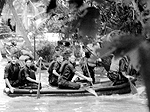 23 November Information received from a local rice farmer resulted in the discovery of a VC base camp and separate storage container. Members of a platoon of three B Company ambush squads lead by 2LT Robert Chavis, located and destroyed the camp situated 100 hundred meters north of the Buong River in the eastern sector of the 720th TAOR. The patrols recovered a hand gun, ammunition, food, counterfeit identification documents belonging to the local VC platoon leader, cooking supplies, propaganda leaflets, and valuable intelligence documents. Ambush Squad #76 destroyed the bunker with a 60 pound case of C4 explosives which turned the area into a large pond.
23 November Information received from a local rice farmer resulted in the discovery of a VC base camp and separate storage container. Members of a platoon of three B Company ambush squads lead by 2LT Robert Chavis, located and destroyed the camp situated 100 hundred meters north of the Buong River in the eastern sector of the 720th TAOR. The patrols recovered a hand gun, ammunition, food, counterfeit identification documents belonging to the local VC platoon leader, cooking supplies, propaganda leaflets, and valuable intelligence documents. Ambush Squad #76 destroyed the bunker with a 60 pound case of C4 explosives which turned the area into a large pond.
Several reconnaissance patrols and night ambushes resulted in the observation of squad and platoon sized enemy movement, seizure of enemy weapons, supplies, sampans and dead local and Main Force VC without any MP ambush squad casualties.
Unknown to the ambush squads at the time, was that the increased activity was a result of the 5th NVA Divisions planning and preparation in the TAOR for their 23 February 1969 Post Tet New Years attack along the southern perimeter (Highway 317) of Long Binh Post.
![]() If you recognize any of the events listed on this Time Line page and would like to contribute Information, personal stories, documents, media articles or photographs pertaining to them, please take a moment to contact the History Project Manager at the Email Link provided above.
If you recognize any of the events listed on this Time Line page and would like to contribute Information, personal stories, documents, media articles or photographs pertaining to them, please take a moment to contact the History Project Manager at the Email Link provided above. 18th Bde.
18th Bde. 720th
720th 95th
95th



